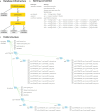The two decades brainclinics research archive for insights in neurophysiology (TDBRAIN) database
- PMID: 35701407
- PMCID: PMC9198070
- DOI: 10.1038/s41597-022-01409-z
The two decades brainclinics research archive for insights in neurophysiology (TDBRAIN) database
Abstract
In neuroscience, electroencephalography (EEG) data is often used to extract features (biomarkers) to identify neurological or psychiatric dysfunction or to predict treatment response. At the same time neuroscience is becoming more data-driven, made possible by computational advances. In support of biomarker development and methodologies such as training Artificial Intelligent (AI) networks we present the extensive Two Decades-Brainclinics Research Archive for Insights in Neurophysiology (TDBRAIN) EEG database. This clinical lifespan database (5-89 years) contains resting-state, raw EEG-data complemented with relevant clinical and demographic data of a heterogenous collection of 1274 psychiatric patients collected between 2001 to 2021. Main indications included are Major Depressive Disorder (MDD; N = 426), attention deficit hyperactivity disorder (ADHD; N = 271), Subjective Memory Complaints (SMC: N = 119) and obsessive-compulsive disorder (OCD; N = 75). Demographic-, personality- and day of measurement data are included in the database. Thirty percent of clinical and treatment outcome data will remain blinded for prospective validation and replication purposes. The TDBRAIN database and code are available on the Brainclinics Foundation website at www.brainclinics.com/resources and on Synapse at www.synapse.org/TDBRAIN .
© 2022. The Author(s).
Conflict of interest statement
MA is unpaid chairman of the Brainclinics Foundation, a minority shareholder in neuroCare Group (Munich, Germany), and a co-inventor on 4 patent applications related to EEG, neuromodulation and psychophysiology, but receives no royalties related to these patents; Research Institute Brainclinics received research funding from Brain Resource (Sydney, Australia), Urgotech (France) and neuroCare Group (Munich, Germany), and equipment support from Deymed, neuroConn and Magventure. SO is Co-Founder of DeepPsy, a deep learning based application for prediction of treatment response in depression.
Figures






References
-
- Berger H. Über das Elektrenkephalogramm des Menschen. Archiv Für Psychiatrie Und Nervenkrankheiten. 1929;87:527–570. doi: 10.1007/BF01797193. - DOI
Publication types
MeSH terms
Substances
LinkOut - more resources
Full Text Sources
Medical

